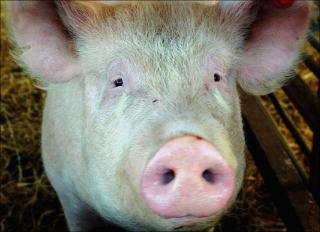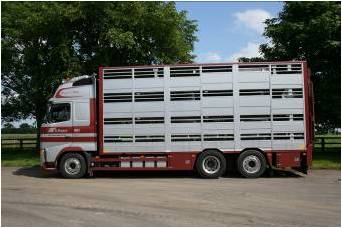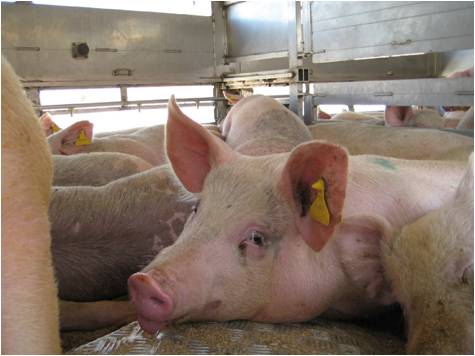Welfare of animals in transit - a sound scientific basis for regulations
Published on 30 August 2010 in Food, health and wellbeing

Introduction
The welfare of animals during transportation is a matter of major public and political concern. The transport of animals for the purposes of relocation, breeding and slaughter may constitute a risk of stress, injury, altered product quality and reduced welfare status. In the EU in January 2007 the “Animal Transport Regulation” EC 1/2005, aimed at protecting the welfare of animals during transportation was implemented.
The legislation is now due for review and possible amendment and it is widely agreed that any changes or modifications must be based upon sound fundamental and applied science and not be derived from emotive concerns or political expediency. A research programme in the UK, mainly funded by Defra, involving collaborations with other EU Member States, particularly Spain, has focussed upon the provision of the basic science required for sound legislation and codes of practice.
Key Points
.jpg) The research programme has addressed the central issue of the acceptable temperature ranges for the transportation of slaughter and breeder pigs. The studies have combined laboratory and comprehensive field studies. The findings provide the sound scientific basis for improved legislation relating to the welfare of pigs in transit and allow practical assessment of the effectiveness of implementation of the current regulation and adequacy of accepted industry practices.
The research programme has addressed the central issue of the acceptable temperature ranges for the transportation of slaughter and breeder pigs. The studies have combined laboratory and comprehensive field studies. The findings provide the sound scientific basis for improved legislation relating to the welfare of pigs in transit and allow practical assessment of the effectiveness of implementation of the current regulation and adequacy of accepted industry practices.
Research Undertaken
 The research programme has focused upon the thermal micro-environment experienced by livestock in transit. The programme has consisted of three phases.
The research programme has focused upon the thermal micro-environment experienced by livestock in transit. The programme has consisted of three phases.
Phase1: Influence of Temperature
The initial focus was upon definition of the acceptable ranges and limits for temperature and humidity for pigs going to slaughter on journeys of up to 8 hours. The studies employed “physiological response modelling” in controlled climate chambers.
The models suggested that:
- There were no major detrimental effects upon pigs of 100kg body weight within the temperature range -10°C to +30°C on journeys of up to 8 hours duration.
- At temperatures of 34-35°C and RH>60% there was evidence of hyperthermia, fatigue and electrolyte / hydration changes.
The study concluded that the recommended thermal envelope (acceptable range) for pigs on normally ventilated transporters should be between -10°C and +30°C for periods of up to 8 hours with absolute minima and maxima of -15°C and +35°C (<65%RH).
Phase 2: Influence of Heat Stress
In this phase this model was evaluated under commercial transport conditions. These studies were undertaken in northern Spain in summer to assess potential heat stress. Slaughter-weight pigs were transported for 8 hours on a route that could be replicated for all the experimental journeys and the on-board thermal environments and physiological responses of the animals were characterized.
The findings indicated that despite high ambient temperatures and elevated thermal loads inside the vehicle, the pigs were not detrimentally affected by the prevailing thermal conditions.
It was concluded that the genetic background of the animals employed and their physiological status in terms adaptation to the climatic conditions result in a relative insensitivity to thermal loads (high temperatures and humidities) which would impose moderate to severe heat stress on animals from other sources.
Phase 3: Influence of European Journeys
 Seven experimental journeys were undertaken from the UK (Edinburgh) to southern Spain during the summer. A number of physiological and behavioural indices were employed to assess the responses of the pigs to transport and to the range of thermal micro-environments. These indices were integrated and correlated with the thermal conditions.
Seven experimental journeys were undertaken from the UK (Edinburgh) to southern Spain during the summer. A number of physiological and behavioural indices were employed to assess the responses of the pigs to transport and to the range of thermal micro-environments. These indices were integrated and correlated with the thermal conditions.
The findings may be summarised:
- The thermal conditions included journeys that might be classified as “mild”, “warm” and “hot”
- On none of the journeys was severe thermal stress identified
- Whilst journeys undertaken in conditions close to or at the limits of temperature prescribed in the current regulation were associated with some physiological adaptive responses, these did not constitute a major threat to the welfare of the animals.
Policy Implications
 These findings have important implications for the development of appropriate legislation and codes of practice applicable to transport of livestock across Europe.
These findings have important implications for the development of appropriate legislation and codes of practice applicable to transport of livestock across Europe.
The results suggest that if transportation is undertaken in a manner consistent with current legislation, on appropriate vehicles and with high standards of personnel and practice, there is little threat to the welfare of the pigs even in relatively hot conditions (and under conditions typical of Southern Europe in summer).
The major issues identified in the studies are:
- the absence of any time limits or durations of exposure to any prescribed temperature limit
- the absence of sound scientific data incorporating factors other than temperature into thermal comfort for pigs in transit (this requires further research)
- the failure to consider the effects of acclimatisation and adaptation to thermal conditions on the risk of thermal stress in transit and the resulting limits prescribed in regulation.
The current European legislation/regulation (EC 1/2005) appears to be adequate generally for the protection of pigs in transit. The available scientific evidence suggests that it may not be necessary to reduce the upper limits to ensure good welfare in transit for slaughter and breeder pigs. No change should be adopted in the absence of scientific evidence clearly demonstrating the advantages of the revisions. The most urgent requirement is the definition of exposure times to any prescribed thermal limit.
Author
Dr. Malcolm Mitchell Malcolm.Mitchell@sac.ac.uk





